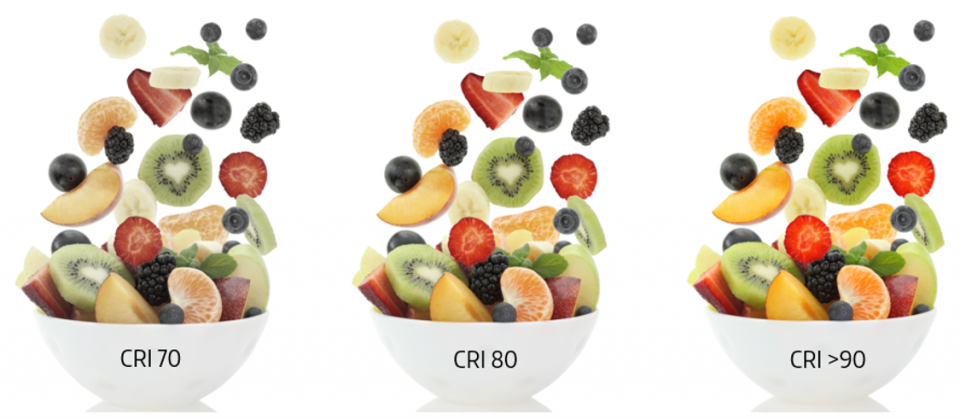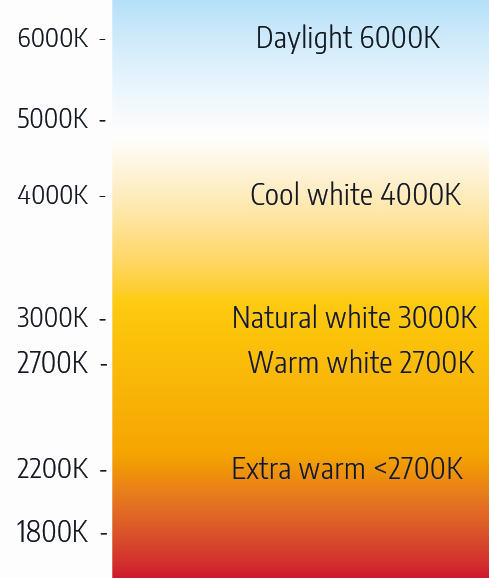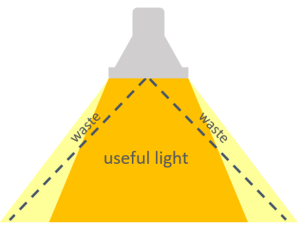Our dedicated Sales team is happy to go the extra mile to help you find the best solution to your lighting needs or to provide you with all necessary information.
Quotation
If you would like to receive a quotation, please fill in the applicable form.
Service & return procedure
We believe in good service and do everything we can to ensure that the quality of our LED lighting remains at a very high level. In the unlikely event that something is wrong with the product, you can use our return procedure.
FAQ
Please have a look at the frequently asked questions. Also we provide a short explanation of most common LED terms. If you cannot find an answer to your question in the FAQ section, you are invited to fill in the general contact form.
-
CRI
De Color Rendering Index (CRI) indicates the ability of a light source to reveal the true colors of its surrounding objects on a scale from 0 to 100: the higher the CRI rating, the more accurate the color rendering.

-
Kelvin
The color of light is defined in Kelvin (K). A high Kelvin value represents a cold white light; a low Kelvin value gives a warm, more yellow color.

-
LED driver
LED lamps require only a very low voltage. To convert the mains voltage to this low voltage, an LED driver is required. The driver provides a constant power supply. The fewer fluctuations, the better it is. Many retrofit lamps have a built-in driver. Some LED lamps come with an external driver supplied separately.
-
Lifespan
The lifespan indicates how long the lamp lasts on average and is defined in operating hours. However, there are several factors that determine which life is actually achieved: see detailed explanation under "frequently asked questions SPL LED" about actual lifespan.
-
Lumen
The rendering of light is usually defined in Lumen (lm). The more Lumen, the higher the amount of visible light. When replacing incandescent lamps by LED the following conversion table can be used to obtain the same light output.

-
Power factor
In electrical engineering, the power factor of an AC electrical power system is defined as the ratio of the real power absorbed by the load to the apparent power flowing in the circuit, and is a dimensionless number in the closed interval of −1 to 1. In an ideal situation, the value is 1. A LED lamp contains electronics and therefore often has a Pf lower than 1. For example: a 10W LED lamp with a Pf of 0.5 actually consumes 10W / 0.5 = 20W. The closer the Pf is to value 1, the better.
-
SDCM/Binning
No LED chip is the same at the microscopic level. During the production of LED chips, differences in color reproduction and light output inevitably arise. After production, they are ideally selected and grouped. This process is called binning. The level at which selection and grouping are ultimately done determines the color consistency of the finally assembled LED lamps. The color deviation is indicated in SDCM (Standard Deviation or Color Matching) from 1 (no deviation) to 6 (large deviation). Filament LEDs cannot reach a score better than 6, while COB and SMD LEDs can easily obtain a 4 or 5. The better the binning, the higher the price of an LED. Click here for more info. (page 28).
-
Voltage
Volt or voltage indicates the electrical voltage that the lamp requires to make it run. The standard power is 230 volts. Different voltages apply for, for example, cars, ships and industrial appliances.
-
Wattage
The wattage of a LED lamp source indicates how much energy it consumes. Voltage times Amp = Wattage. To know how much light an LED lamp really gives and which LED is the equivalent of which incandescent lamp, it is best to look at the amount of Lumen. Lumen per Watt differs from one LED to another.
-
Can 100-250V also be dimmable?
No; until now, one has to choose. If you want a LED that can be used on both 110V and 230V, it cannot be made dimmable.
-
Can I mix various filament LEDs on a dimmer?
All PREMIUM filament LEDs have the same flicker-free driver, regardless of the shape, the number of sticks or helixes or their length. This PREMIUM line is therefore perfect for all kinds of projects. The SPL article numbers for this series all start with “LF”.
-
Can I use an industrial LED at home?
Many LEDs can be used within different segments. For example, we consider a 10-60V voltage ranged LED to be a perfect example of our industrial applications category. Nevertheless, the same lamp will do perfectly well in your 24V garage fixture, too.
-
Can SPL 12V LEDs be used on a halogen transformer?
This differs per product and is indicated on the individual product datasheet. Missing information can be requested from our technical department. In general, there are 3 types of transformers:
1. Old-fashioned ferromagnetic transformers. These can sometimes be used for LED, provided that the minimum wattage applicable to the transformer is connected, otherwise the LEDs may flicker. Disadvantages: these transformers often give 13V or 14V instead of exactly 12V, which is harmful for the LED (which gets too hot). They can also buzz and the hidden energy usage is high.
2. Electronic transformers. Usually not suitable for LED because the necessary minimum load is too high and is not achieved with LED.
3. LED transformers or drivers. Perfectly suited for LED because no minimum load is required and they have almost no hidden energy usage.
-
Can SPL LEDs be used outdoors?
This depends on whether the lamp is mounted outside in a fixture or not. If the fixture has a good IP value, the lamp can be used in this fixture. If the fixture is not waterproof, it depends on the IP standard whether the lamp can be used outdoors or not. If a fixture is not watertight, the possibility of outdoor usage depends on the IP rating (Ingress Protection rating). The IP standard indicates the degree of protection of the LED lamp against the intrusion of solids or liquids and consists of 2 digits. The first figure indicates the solids protection (0 to 6). The second digit indicates the liquids protection (0 to 8). The higher the number, the more resistant the lamp is. For example, an LED lamp rated IP21, has a 2 for solids protection and a 1 for liquids protection.
A standard LED has IP20 and cannot be used outside just like that. SPL does have LEDs with IP65 that can be used in garden spots, for example. All LEDs >IP20 are marked as such.
IP solids protection
0 = No protection
1 = Protection against objects larger than 5 cm (e.g. hand)
2 = Fair protection- against objects larger than 1.25 cm (e.g. finger)
3 = Protection against small objects
4 = Protection against pointed objects
5 = Good protection
6 = 100% protectionIP liquids protection
0 = No protection
1 = Protection against vertical drop
2 = Protection against drops at an angle of 15 degrees
3 = Splash proof
4 = Water resistant, suitable for the bathroom
5 = Spray resistant
6 = Water resistant provided the lamp is not fully submerged in water
7 = Immersion resistant, can be kept under water for a short time
8 = Fully water-resistant, also under water -
How do I choose the right LED?
First determine the application / category. For example, an LED for general or home use is subject to different requirements than an LED for professional application. Within a category, a number of characteristics determine which LED is most suitable.
• Lumen: determine how much light output is needed or desired.
• Kelvin: determine what light color the LED should render.
• Beam angle: determine whether the lamp must have a wide light beam (flood) or a narrow light beam (spot).
• CRI: determine how well the lamp should display the color of its surrounding objects. Generally, CRI82 is sufficient. For projects where true color rendering is important, CRI90 or higher is recommended.
• Binning / SDCM: determine to what extent color deviations between lamps are acceptable. A consumer will easily be able to handle SDCM6. Project illuminators will often choose SDCM3.
• Warranty: determine which warranty period is desired. 2 years is standard. Many projects however require a longer warranty.
-
If I want to use multiple LEDs with an external driver, can I also replace the individual drivers with 1 driver?
Yes, that is possible. We will then produce a technically different LED. With one external driver, 36V is usually applied. For example, if you want to run 10 LEDs on one single driver, we change the LED to 12V and one driver will be supplied along with them. Soon we will be offering the possibility to choose from "LED packages", so that it is immediately clear which LEDs can be combined with which driver.
-
What is the 90 degree cone?
According to EU rules, the effective Lumen must be specified for directional lighting. This is determined according to the principle of the 90 degree cone and represents the useful / usable light output in Lumen that is located in a beam angle of 90 degrees. The emitted light outside the cone is considered to be stray light hence waste.
The 90 degree cone is measured with a Goniophotometer. For directional light, SPL mentions both the total Lumen (light output in all directions) as well as the 90 degree cone.

-
What is the actual lifespan of an LED lamp?
The theoretical lifespan of an LED is determined after testing and is defined in a number of operating hours. However, it is difficult to predict which life span will actually be achieved, because several factors are decisive, such as:
• The number of times the LED is switched on and off.
• The number of operating hours per day / week / year.
• The heath dissipation in the LED (larger lamps have larger heat sinks).
• The luminaire and the environment in which the LED is being mounted.
• The quality of the electronic components.
Below please find a more detailed explanation:
L70 rule
An LED does not stop working spontaneously, but after a while the amount of Lumen will become too weak to be functional. The L70 rule indicates after how many operating hours a lumen drop of 30% will occur. This moment in time is considered to be the moment at which an LED must be replaced.Electronic components
The weakest link in the lamp is not the LED itself but the underneath electronic components. Upon switching on an LED lamp, a small peak current occurs and causes extra pressure onto the components (inrush current). This shortens the lifespan of said components.Heat dissipation
Electronic components are subject to a maximum thermal load (specified per component) and degrade faster if that limit is often or continuously reached. For lamps with a small housing, the heat dissipation is often just adequate and the electronic components will not reach their theoretical operating hours. Larger LED lamps that are used in factories have large heat sinks and are likely to achieve the specified operating hours as all the electronics can be cooled sufficiently.Calculating operating hours
Theoretically, one can convert the number of operating hours specified to years. Suppose you let a lamp with allegedly 50,000 operating hours run continuously: this would result in 5.7 years. With 8 operating hours per day, this would result in 17.1 years. That sounds fairly good, but it does not work that way in practice. To make a realistic estimate, you must include all other life-shortening factors in the calculation. The warranty on an LED is eventually defined in years (usually 2 - 3 years) and not in number of operating hours. -
Which dimmer should I use with the SPL LEDs
This differs per LED and depends from the configuration. A dimming list can be requested for each LED, with SPL advising the most common dimmers. If the customer has a dimmer that is not listed, we will have it tested and added by our technical department. Even when working with special systems such as Dali, the technical department can also provide advice.
-
Why is SPL divided into different categories?
SPL offers LEDs in four different categories. In addition, SPL has a separate category for accessories. Working with different segments enables us to guide our customers towards the LED that suits their specific needs. Furthermore, we can e.g. prevent a consumer LED from being used in industrial environment where other requirements apply.
